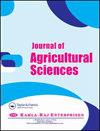Rainwater harvesting with polyethylene film covered ridges for pumpkin (Cucurbita pepo L.) seed production under semiarid conditions
IF 0.7
Q3 AGRICULTURE, MULTIDISCIPLINARY
引用次数: 2
Abstract
The aim of the study is to evaluate effectiveness of a rainwater harvesting technique with polyethylene film covered ridges (RHCR) on pumpkin seed production under rainfed conditions in Kayseri/Turkey. For this purpose, a two-year experiment, of which were consisted three covered ridge widths (R 1 = 0.5, R 2 = 0.7, and R 3 = 0.9 m) and a control treatment, was conducted. The experimental design was completely randomized plots in blocks with three replications. Significantly higher seed yields were obtained from R 2 and R 3 (202 and 208 kg ha -1 ) in first year and from R 2 (660 kg ha -1 ) in second year. Although excessive drought conditions were experienced during pumpkin growing period in those years, especially R 2 treatment resulted significantly higher yield. Higher plant density in R 1 and lower density in R 3 negatively affected seed yield especially in water scarce second year. In second year, leaf area, mean fruit weight, fruit yield, seed yield and 1000-seed weight were found higher than ones in first year because of application of nitrogen a whole at sowing. We concluded that RHCR with optimum plant density and proper covered ridge wide, and application whole nitrogen at sowing under rainfed conditions are effective ways to obtain higher pumpkin production in semiarid regions.半干旱条件下聚乙烯膜垄雨水收集用于南瓜种子生产
本研究的目的是评估聚乙烯膜覆盖垄雨水收集技术在土耳其开塞利省旱作条件下南瓜籽生产中的有效性。为此,进行了为期2年的试验,试验采用3种盖脊宽度(r1 = 0.5, r2 = 0.7, r2 = 0.9 m)和1个对照处理。试验设计为完全随机分组,每组3个重复。r2和r2第一年(202和208公斤公顷-1)和r2第二年(660公斤公顷-1)的种子产量显著提高。虽然这些年份南瓜生育期经历了过度干旱,但特别是r2处理显著提高了产量。植株密度较高的r1和密度较低的r3对种子产量有不利影响,特别是在缺水的第二年。由于播期全施氮肥,第二年的叶面积、平均单果重、单果产量、籽粒产量和千粒重均高于第一年。结果表明,在半干旱区,适宜的种植密度和适当的覆盖垄宽,以及在旱作条件下施全氮是提高南瓜产量的有效途径。
本文章由计算机程序翻译,如有差异,请以英文原文为准。
求助全文
约1分钟内获得全文
求助全文
来源期刊

Journal of Agricultural Sciences
AGRICULTURE, MULTIDISCIPLINARY-
CiteScore
1.80
自引率
0.00%
发文量
0
 求助内容:
求助内容: 应助结果提醒方式:
应助结果提醒方式:


